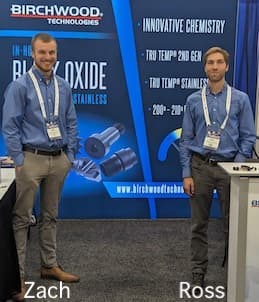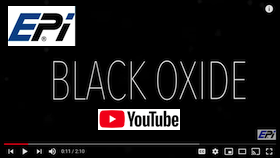
-----
Black oxide problems on 4340 steel
Q. Hello. My name is Todd and we are having finish issues on parts that looks like water spots; and where induction areas are, they do not black like the rest of the parts. Temp on the black tank is at 210 °C
Todd Lutkenhaus- Mebane NC
May 13, 2022
A. Hello Todd,
I'm sorry you were experiencing issues with your black oxide process! Are these still continuing to this day?
Black oxide is a conversion coating, so surface condition of the parts going into the process has a large impact on the quality and uniformity of the coating coming out. Heat treat defects can create spots that are a different color than the rest of the part as you describe. Some resolve this issue with the heat treat process to minimize defects and others solve it with either pickling or sand blasting to create a more uniform surface.
adv.
I believe you are using our Tru Temp chemistry, assuming you mean 210 °F on the temperature. Please do not hesitate to reach out to Birchwood Technologies [a finishing.com supporting advertiser] for technical support from our chemists to help get the most out of your black oxide process.

Zach Johnson
Birchwood Technologies
Eden Prairie, MN
⇩ Related postings, oldest first ⇩
Q. Hi, I am a materials engineer; we perform black oxide coatings on 4340 steel, that is nitrided and heat treated before coating. But recently I have parts with some smut (of rusty color) which comes off on the hand when rubbed. In the MIL-DTL-13924 [⇦ this spec on DLA] standard is written that some smut is acceptable. Maybe somebody knows what the source of that smut is, and if this is really acceptable?
Yonathan Grossengineer - Israel
August 31, 2010
A. I have been forced to blue a lot of 4340 and 4350 steel over the years unfortunately. It is a nice material for hard wearing parts that must resist shattering like gears and gun parts but it is a bit of a headache where bluing is concerned. It has a tendency to what we in the firearms industry call frosting or silver spotting. This means the finish can take on a myriad of tiny white spots that can look like frost. Sort of like a gloss black paint job with tiny metallic flake. Why it does this particular pattern I can't tell you, I'm not a chemist. But it looks horrible and the silver spots do later rust more easily. I can tell you that it is linked to the high nickel content in these steels. All high nickel steels do it.
The harder the steel is tempered to, the worse this problem gets. It can be corrected in the bluing process though by dragging the temperatures of the bluing bath up to very dangerous temperatures. By dangerous I mean that at a certain temperature which is some where between 310 and 350 °F, depending on the salt mix the bath will cook out and be destroyed. By bringing the salts to a near maximum temperature these high nickel steels will blue but there is a trade off. To get the salts up to that temperature one must boil off a great deal of the water. The salt to water ratio of the bath is very critical. We use temperature as a guide to this ratio. If the concentration of the bath gets too high the steel smuts or can even rust and etch. To low and the parts will not blue. To blue the nickel steels you have to brush the very edge of the envelope where excessive rusting or smutting will occur. The trick is to bring it to the smutting point and hold it just there and not let it get to the point where it can rust and pit the steel.
With that long winded explanation you now know that YES, the smutting is normal and acceptable. So long as there is no pitting. What is NOT acceptable is that during the boil out and oiling of the blued parts the smut should be carefully removed with very light rubbing with #0000 steel wool
⇦ on
eBay or
Amazon [affil link] and water or paper towels and then oiled to protect the blued finish. If the rust or smut is left on it tends to cause a light degrading of the finish over time after the parts are put into storage. The blue will loose its shine and it can develop fine pits. I have no idea what affect nitrating might have on the bluing. But, I almost have to think that the bluing might have an adverse affect on the nitrating, but I have no experience with it.

Rod Henrickson
gunsmith - Edmonton, Alberta, Canada
September 2, 2010
A. This is probably acceptable, however a smear test should be conducted to test for rub off.the remaining color should be a deep rich black with no brown/red/ or bare metal showing. The smut is most likely a carry-over from the bath. This often happens when the part dries too quickly prior to rinsing.
Daniel BianchinoBlack Oxide supervisor - Albany, New Hampshire, USA
September 3, 2010
Q, A, or Comment on THIS thread -or- Start a NEW Thread
